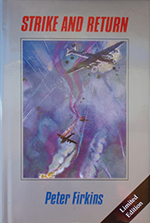
Strike and Return
The story of the exploits of No. 460 RAAF Heavy Bomber Squadron, R.A,F. Bomber Command in the World War.
This is the intimate story of one of the great bomber squadrons of World War11. It is almost an almanac of the day to day fortunes of the airmen of 460 Squadron, RAAF who were engaged in one of the toughest battles in the history of the war.
Day after day, night after night, sometimes with great success, sometimes with grievous loss, these men flew against a determined and skilled enemy, to attack targets defended by the greatest concentration of artillery, night fighters, searchlights and radar devices the world had ever known.
This story is based on the experiences and impressions of individual crews recorded immediately on return from operational missions and is therefore a factual and accurate account of events as seen through the eyes and imprinted on the minds of those who were in combat with the enemy. As such it makes a valuable contribution to the history of the Bomber Offensive in the West.
The book includes a list of 1000 airmen lost on 460 Squadron. Altogether 5000 young Australians died in Bomber Command. Some who read this story and who may not have had the opportunity to study the higher strategy of the Allies in World War 11, may be wondering whether the loss of so many gallant young men was worth while and how much their sacrifice contributed to final victory and the defence of Australia.
To see the matter in true perspective, it is necessary to appreciate the magnitude of the Bomber Offensive and understand the part it played in the strategy of the war.
The front line strength of Bomber Command in January, 1945 was ninety–five squadrons and in the course of the war the Command dropped slightly less than one million tons of bombs. The United States Air Force operating from bases in the United Kingdom, dropped a little over 600.000 tons.
The policy for the selection of targets and target systems was controlled by Combined Chiefs of Staff of Britain and the United States and the War Cabinet and was an integral part of the general strategy of the war. It had been prepared and approved at the Casablanca Conference and issued as a directive.
Let it suffice to point out that the war was brought to a successful conclusion very much earlier than would otherwise have been possible and at a lower cost in human life. As a direct outcome of the correct and vigorous use of Air Power, of which the Bomber Offensive was the corner stone, it was possible for our armies to land on the heavily defended beaches of Normandy and press deep into the heart of Germany. Speed too was the essence, as Germany was well ahead in the development of atomic weapons. Their introduction would have undoubtedly changed the course of the war. A victorious Germany would have meant a victorious Japan and Australia as we know it today would not exist.
Bear in mind that aircrew were mostly young men on the threshold of life, facing odds of about 2 1/2 to 1 against surviving a full operational tour in Bomber Command. Rarely, if ever before, had fighting men had to face such a contrast in living. At two o'clock in the morning they would be flying through the fiercest artillery barrage and night fighter defence system ever devised. A few hours later they could be drinking in the enchanting surroundings of an old English inn with the knowledge that soon they would have to face the same terrible carnage of total war and the hellish and fearful nightmare experience of flying through the German air defences. Or, of course, be dead or grievously wounded, a prisoner of war or fighting for life to abandon by parachute a burning and doomed aeroplane. And this they had to do 30 times to complete their first tour of operations.
The foregoing is an extract from the foreword to "Strike and Return" (the motto of 460 Squadron) presented by Basil Embry.
Peter Firkins book is almost a day to day history of 460 Squadron. It includes a listing of every raid made by the squadron, including the aircraft lost. A useful appendix gives the operational performance of German night fighters and R.A.F bombers. Included is a listing of 1000 members of 460 Squadron who were killed in action.